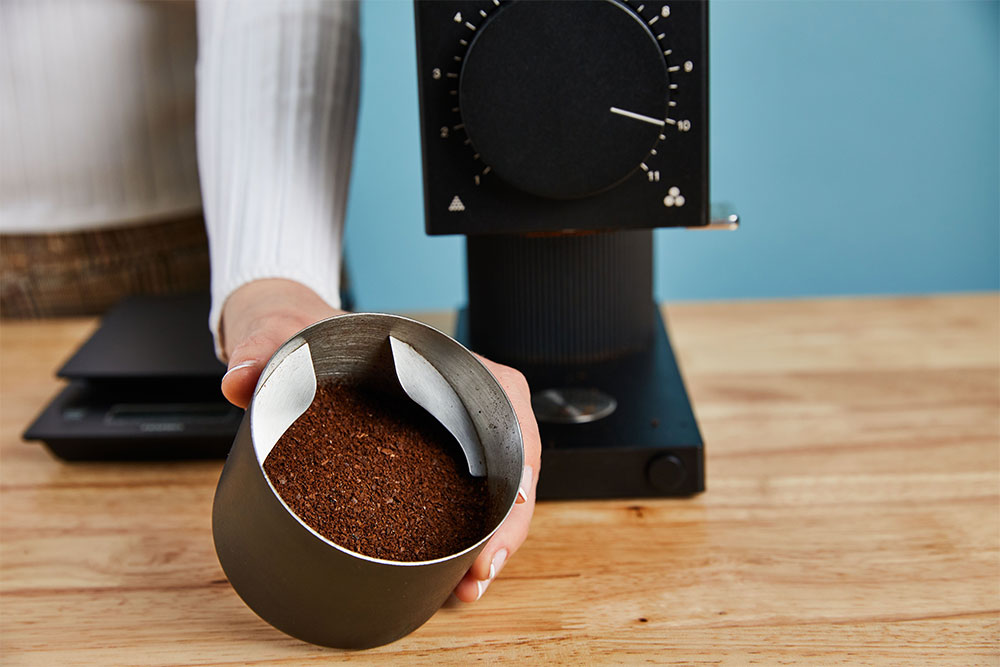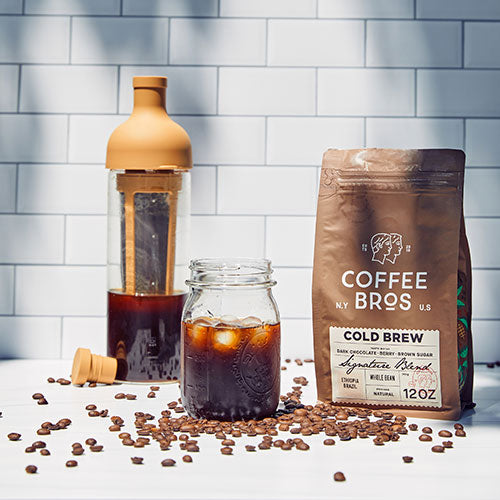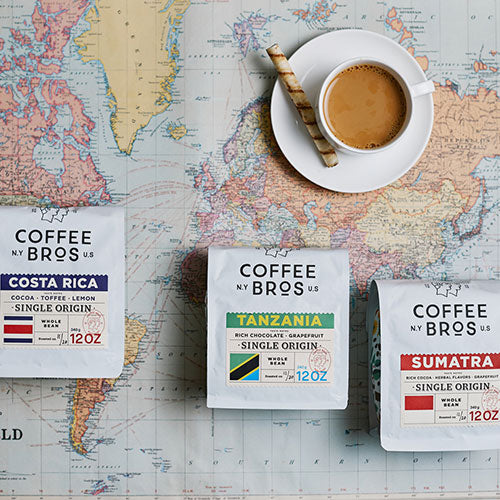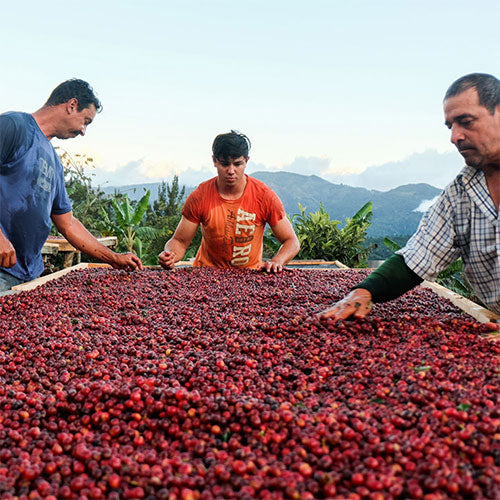The real difference between Light, Medium, and Dark roasted coffee
Introduction
Coffee roast levels or color descriptors can be described in a scale of; Light, Medium, and Dark or using once-common descriptors such as Cinnamon, City, Full City, French, and Italian.
While roasters, including us, have tried to use a simplified scale, it often leads to additional confusion as one roaster may describe a light roast as one depth of color. In contrast, another describes it as something else entirely.
We wanted to present this blog as a resource of what certain levels actually mean, using real-world examples and drawing a line on a chart to show where moving beyond a certain roast level, a coffee loses all of its terroir (how the origin of the coffee, its soil, climate, and elevation all impart and impact the quality, flavor, and taste of the coffee).
While it looks to impact many areas of coffee, the specialty coffee roasting movement intends to preserve and showcase the terroir of the coffee bean itself. Roasting to or beyond a specific level alters the sensory notes to be more wholly or heavily influenced by the roasting process versus capturing and highlighting the origin characteristics.
Today, we’ll introduce Agtron color readings (and how that helps us identify roast level), showcase our version of the roast development scale, and give you real-world examples of where other coffees labeled light, medium, or dark may fall on that scale and where the line is drawn before a coffee loses its terroir and origin characteristics.
Coffee Subscription Deal
Subscribe to Coffee Bros. coffee for 25% off when using code "FTSUB25" at checkout
Table of Contents
- What is the Agtron Color Scale
-
What do Coffee Roast Levels Mean
- Very Light
- Light
- Light Medium
- Medium
- Specialty Dark
- Dark
- Very Dark
- How the Definition of Dark Roast Comes Down to the Loss of Terroir
- Coffee Bros. Coffee vs. Others on the Roast Development Scale
What is the Agtron Color Scale
One of the main challenges faced by specialty coffee roasters is ensuring consistency in quality control. To achieve this, the classification and quality of roast are given top priority in day-to-day production. While sophisticated equipment and chemical analysis are employed in accurate quality control programs, they often exceed most roasters' financial and technical capabilities. Cupping is the ultimate assessment of roast quality, relying on a well-trained palate. However, when classifying the degree of roast, the specialty coffee industry needs to establish standards or references. Furthermore, there needs to be more consensus among coffee professionals and consumers regarding the language and terminology of roast classification.
To address these issues, the Agtron and SCAA Roast Classification system aimed to create a numerical index and standardized roast levels to mitigate nomenclature controversies. The Agtron number refers explicitly to an infrared reflectance measurement of a roasted coffee sample, specifically targeting the caramelization of sucrose. This measurement correlates directly with the flavor chemistry associated with the degree of roast. It's important to note that the infrared band used by the Agtron color meter falls outside the visible spectrum of the human eye and does not reflect how an individual would perceive the coffee.
The Agtron and SCAA Scale:
| Agtron # | SCAA Names |
| 91 - 130 | Extremely Light |
| 81 - 90 | Very Light |
| 71 - 80 | Light |
| 61 - 70 | Medium Light |
| 51 - 60 | Medium |
| 41 - 50 | Moderately Dark |
| 31 - 40 | Dark |
| 0 - 30 | Very Dark |
While the above is helpful, it still makes it difficult for consumers to know what they get when purchasing a “Medium” or “Dark-roasted” coffee.
To help with that, we slightly modified the Agtron scale and SCAA names to draw a line in the sand at the point where the roast level impacts cup characteristics to the point of eliminating any terroir. For us and many other specialty coffee roasters, roasting beyond this point is not objective when showcasing high-quality and high-scoring coffees.
Our proposed Agtron scale eliminates the extremes; coffee roasted too light for enjoyment or so dark it is not palatable. Our scale draws the line at #55, stating that coffees below this figure begin to lose origin characteristics, and notes most attributed to the roaster, like smokiness and burnt notes, will be present.
Finally, adjusting the nomenclature to associate more closely with how specialty coffee roasters today define their coffees is more helpful when shopping for coffee online. Later in the blog, we’ll show you where the old guard of coffee companies sit on this scale and how their definition drastically differs from how specialty coffee roasters define their coffee.
Moving forward for the remainder of the blog and throughout our product pages you will see references to the scale below.
Our Scale:
| Agtron # | Roast Level |
| > 90 | Very Light (Nordic) |
| 80 - 90 | Light |
| 70 - 79 | Light Medium |
| 62 - 69 | Medium |
| 55 - 61 | Specialty Dark |
| 50 - 54 | Dark (Loss of Terroir) |
| < 50 | Very Dark (Complete Loss of Terroir) |
How the Definition of Dark Roast Comes Down to the Loss of Terroir
Our darkest coffees fall within the “Specialty Dark” range and our darkest coffee hovers just above the range where the loss of terroir might occur. Coffees roasted within the “Specialty Dark” range, and if sourced well, can still be bold, round, and have lots of caramelization, with notes of dark chocolate, brown sugar, and a hint of fruit acidity and sweetness. This makes a great cup of dark coffee, whether used as a drip of a big-bodied espresso with thick crema.
When moving beyond the “Specialty Dark” range, coffee roasted to the Dark or Very Dark range usually means the coffee is of lower quality and is roasted that dark to help mask imperfections.
Specialty coffee roasters look to showcase producers and their efforts in creating high-quality and high-scoring coffees, and pushing a coffee to the Dark or Very Dark level not only does a disservice to the coffee itself but also to the producer’s efforts in growing and processing that coffee.
The efforts toward quality control and sourcing are drastically different for coffees falling in the “Very Light” to “Specialty Dark” range versus anything above.
While the term “Dark” to the consumer usually points to a coffee that is richer and bolder than “Medium” or “Light” roasted coffees, it should also be noted that coffee roasted too dark usually means the coffee is of lower quality and what you taste in the cup in 100% influenced from the roasting process versus the producers’ growing efforts.
Coffee Bros. Coffee vs. Others on the Roast Development Scale
If you are a fan of our coffees, you may already have a general idea of where our coffees labeled as “Light,” “Medium,” and “Dark” fall on the below scale in comparison to other roasters, but it is still interesting to look at. Coupled with the definitions outlined in the previous section, you will better understand how roast color can correlate with roasting development, cup characteristics, and, ultimately, the highlighting or masking of origin and terroir.
As noted, the range of “Specialty Dark” is the darkest we as a company will roast as any coffees roasted beyond this point begin to lose their underlying characteristics. If you are a specialty coffee consumer looking to taste 100% of the origin characteristics of a coffee, you’ll want to find coffees in the Very Light (though these can be very bright) to the Light Medium range. If you are okay with further development, caramelization, and additional body, but the origin characteristics remain, choose coffees in the Medium range. Finally, those seeking the maximum development with a slight loss of terroir and acidity find coffees in the Specialty Dark range.
The darkest we have roasted to date is our Brazil Single Origin offering which comes in at 57.7 on the Agtron scale and what we classify as "Specialty Dark." Anything below 55.0 would exhibit cup characteristics more heavily impacted by the roaster, and loss of terroir would be evident.
The goal of the below scale is to showcase and illustrate where our coffees fall compared to others to give those who may need clarification about color indicators some comparable coffees, they may have experienced at one time or another.
While not extremely robust with a ton of other coffees, the scale should give you an idea of our roast preference and range. If you want to see a specific brand on this scale, please email us, and we will consider adding them!
| Coffee | Agtron # | Roast Level |
| Very Light (Nordic) | > 90 | Very Light (Nordic) |
| Tim Wendelboe Kagere | 95.6 | Very Light |
| Light | 80 - 90 | Light |
| 80.0 | Light | |
| Light Medium | 70 - 79 | Light Medium |
| Stumptown Hair Bender | 73.8 | Light Medium |
| Medium | 62 - 69 | Medium |
| 68.9 | Medium | |
| 68.5 | Medium | |
| 68.5 | Medium | |
| 64.8 | Medium | |
| Peet's Luminosa (Light) | 62.7 | Medium |
| Lavazza Super Crema (Medium) | 62.5 | Medium |
| Specialty Dark | 55 - 61 | Specialty Dark |
| 60.4 | Specialty Dark | |
| 60.2 | Specialty Dark | |
| 57.7 | Specialty Dark | |
| Starbucks Veranda (Light) | 55.4 | Specialty Dark |
| Dark (Loss of Terroir) | 50 - 54 | Dark (Loss of Terroir) |
| Peet's Big Bang (Medium) | 53.3 | Dark |
| Very Dark (Complete Loss of Terroir) | < 50 | Very Dark (Complete Loss of Terroir) |
| Starbucks Pike Place (Medium) | 42.8 | Very Dark |
| Peet's Major Dickason (Dark) | 42.4 | Very Dark |
| Starbucks Verona (Dark) | 39.7 | Very Dark |




